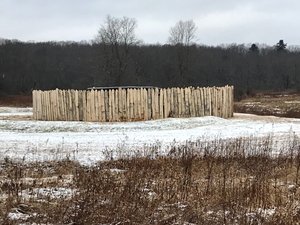Advertisement
Published: February 24th 2022

 For Necessity
For Necessity
Reconstruction of the Fort Necessity stockade. National Register of Historic Places 66000664. IMG_1843Returning home from a visit to Pittsburgh, we found the Pennsylvania Turnpike has been closed due to an accident. Traffic was detoured at New Stanton. We decided to follow US Highway 40 to I-68, where we could rejoin I-70 at Hancock, Maryland. Serendipitously, signs came up for For Necessity Battlefield. A chance to turn a detour into a visit to an historic site. We pulled in to the visitor center parking lot. A park ranger was on duty, but Susan and I were the only visitors on a snowy day. We watched the park film about George Washington and the mission that led to the Battle of Fort Necessity on July 3, 1754.
Washington was in his twenties when he led a company of Virginia Militia into the frontier to convey a request to the French at the Forks of the Ohio (today's Pittsburgh) to vacate the region. The Virginia colony wanted its traders and settlers to be able to move unobstructed into the Ohio Country and today's southwestern Pennsylvania. Both the British and the French were trying to establish alliances with the Native Americans in the region. A clash between French forces and Washington's militiamen and their Mingo tribal

 End Post of Fort Necessity
End Post of Fort Necessity
On July 4, 1754 French troops pulled up most of Fort Necessity's white oak posts and piled them against what was left of the stockade. Then they lit it all on fire. Buried below ground, these post ends survived the blaze and were unearthed by archaeologist J.C. Harrington almost 200 years later. IMG_1832allies led to the death of Joseph Coulon de Villiers de Jumonville, the French commander. It was disputed who had killed Jumonville. Washington, anticipating a French counterattack, established a stockade he called Fort Necessity. The expected French attack led to Washington's surrender. As part of the surrender terms, Washington took responsibility for Jumonville's death. The battle at Fort Necessity in the summer of 1754 was the opening action of the French and Indian War, which escalated into the Seven Year's War.
The Visitor Center also includes exhibits on the National Road. The National Road was built in 1811-1837 between Cumberland, Maryland and Vandalia, Illinois. By 1818 it had reached Wheeling on the Ohio River. The road largely followed Washington's route into the frontier, which later became an improved military wagon road under British General Braddock (Braddock Road). In the 20th Century, the route became US Highway 40. The National Road enabled settlers, stagecoaches and traders to travel into the Ohio Country and beyond.
Advertisement
Tot: 0.063s; Tpl: 0.013s; cc: 13; qc: 30; dbt: 0.0338s; 1; m:domysql w:travelblog (10.17.0.13); sld: 1;
; mem: 1.1mb

 For Necessity
For Necessity
 End Post of Fort Necessity
End Post of Fort Necessity








